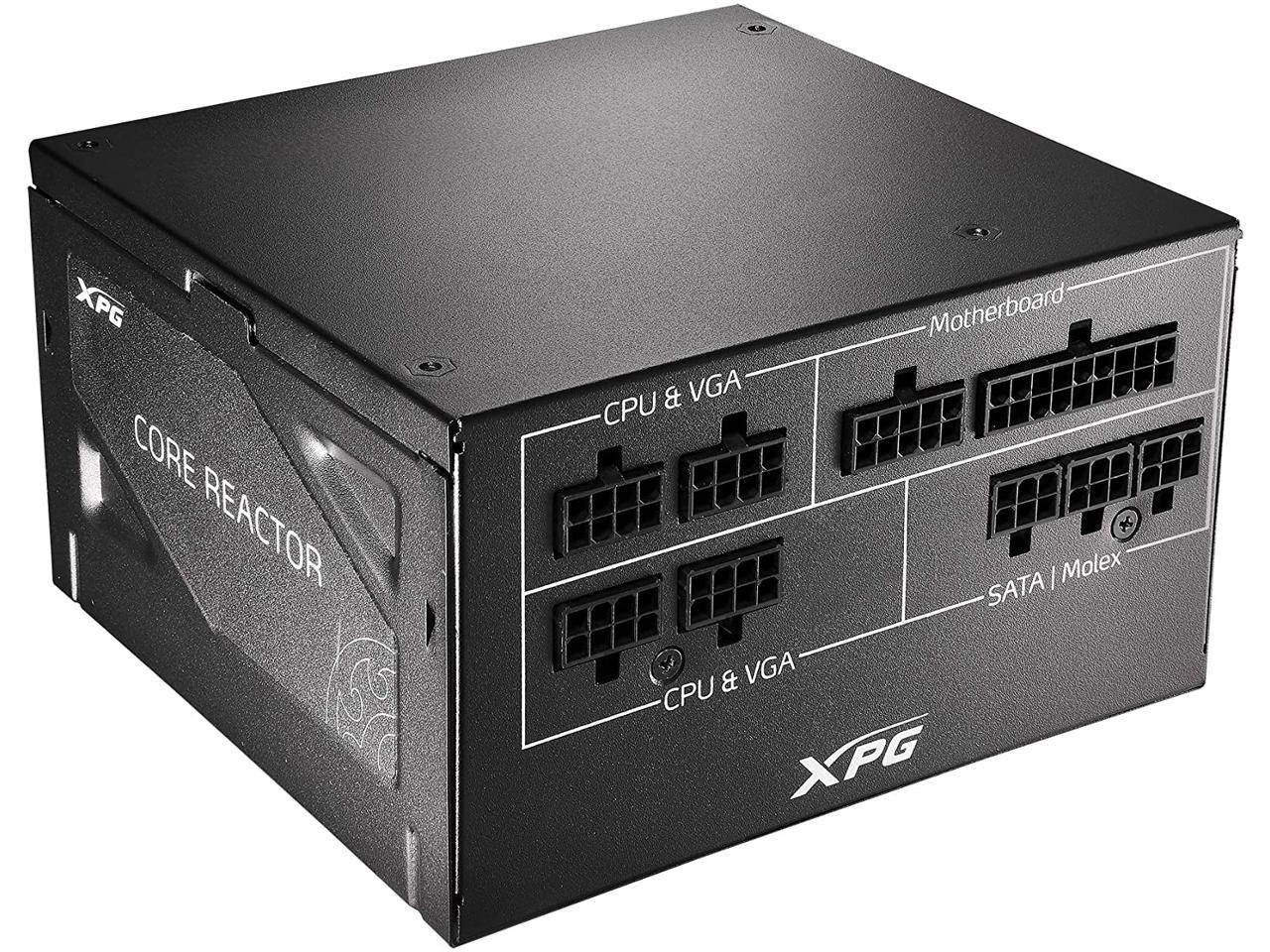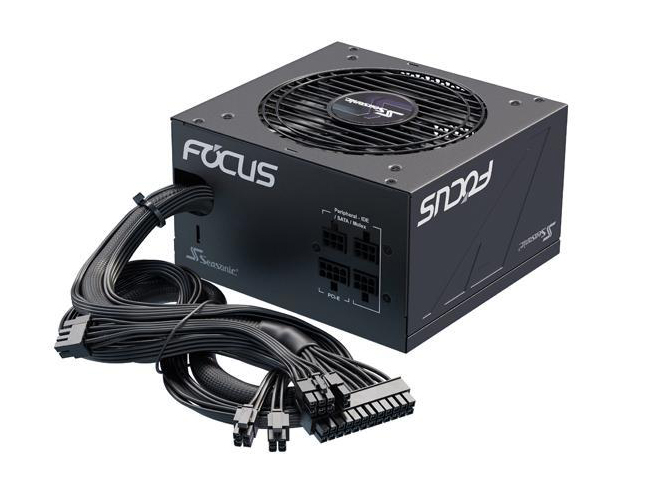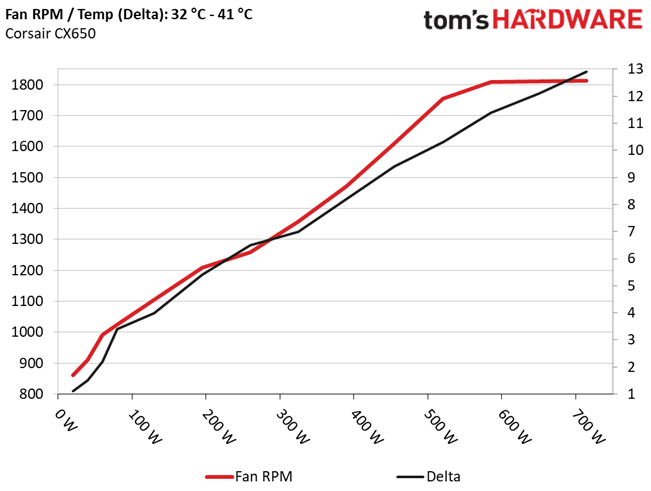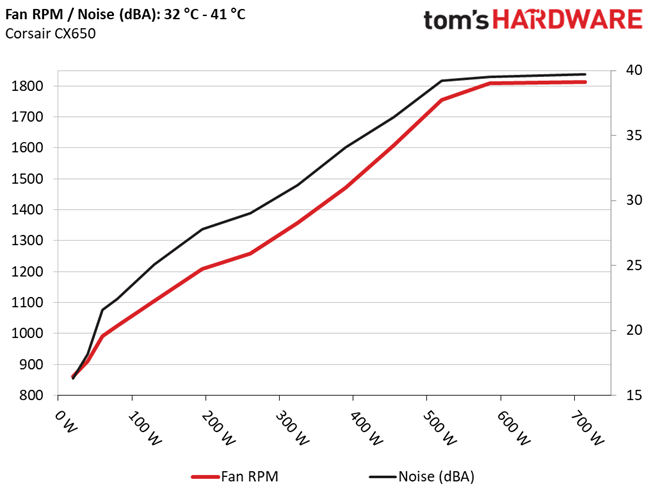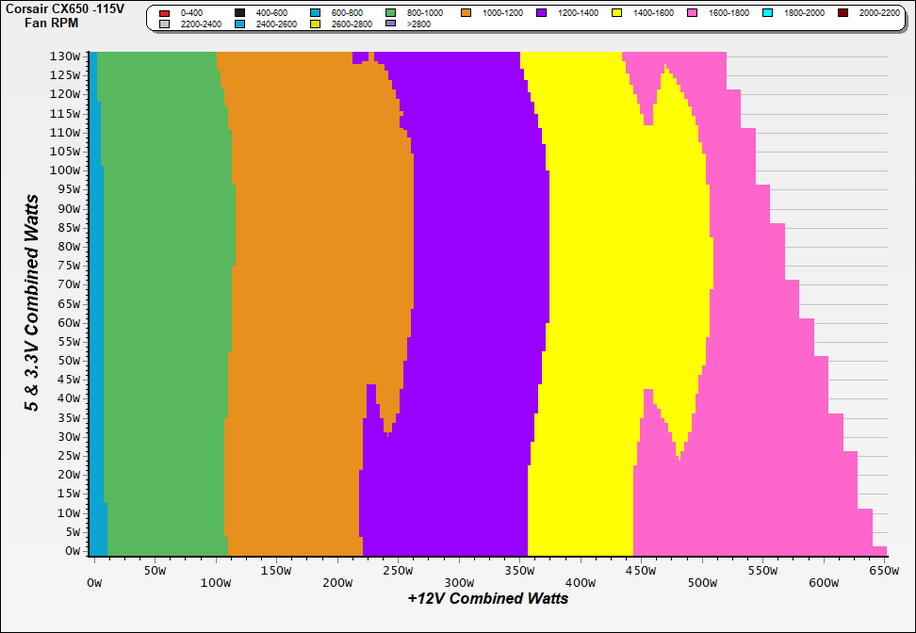Why you can trust Tom's Hardware
To learn more about our PSU tests and methodology, please check out How We Test Power Supply Units.
Primary Rails And 5VSB Load Regulation
The following charts show the main rails' voltage values recorded between a range of 40W up to the PSU's maximum specified load, along with the deviation (in percent). Tight regulation is an important consideration every time we review a power supply because it facilitates constant voltage levels despite varying loads. Tight load regulation also, among other factors, improves the system’s stability, especially under overclocked conditions and, at the same time, it applies less stress to the DC-DC converters that many system components utilize.

Results 1-8: Load Regulation





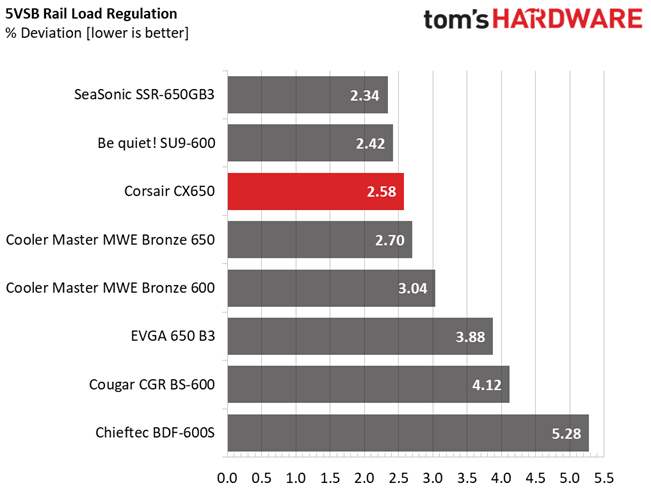
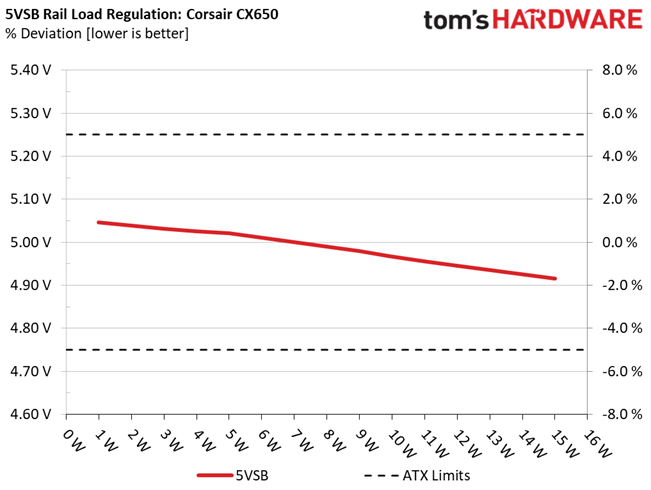
Load regulation is tight, especially at 12V where it matters the most.
Hold-Up Time
Put simply; hold-up time is the amount of time that the system can continue to run without shutting down or rebooting during a power interruption.

Results 9-12: Hold-Up Time



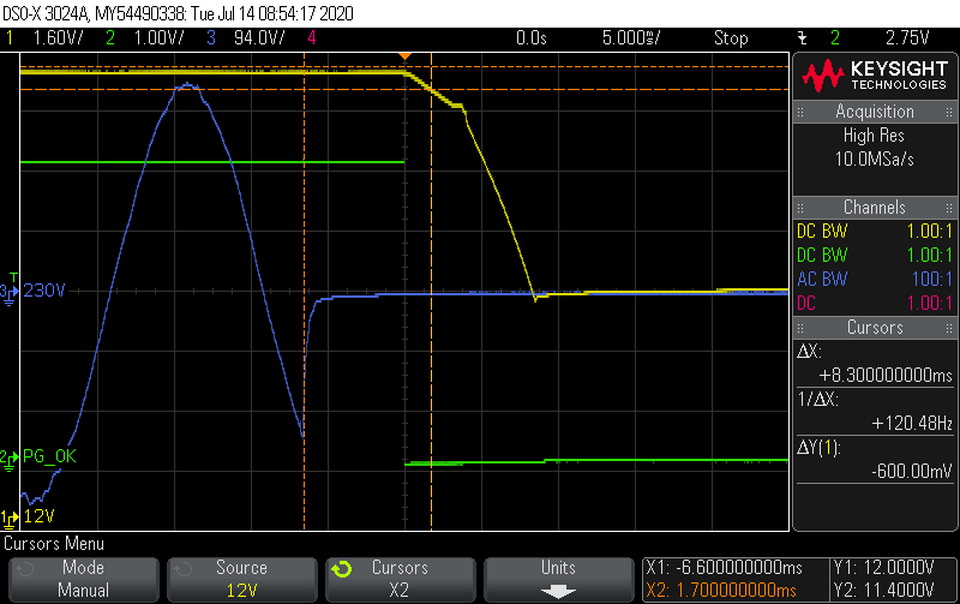
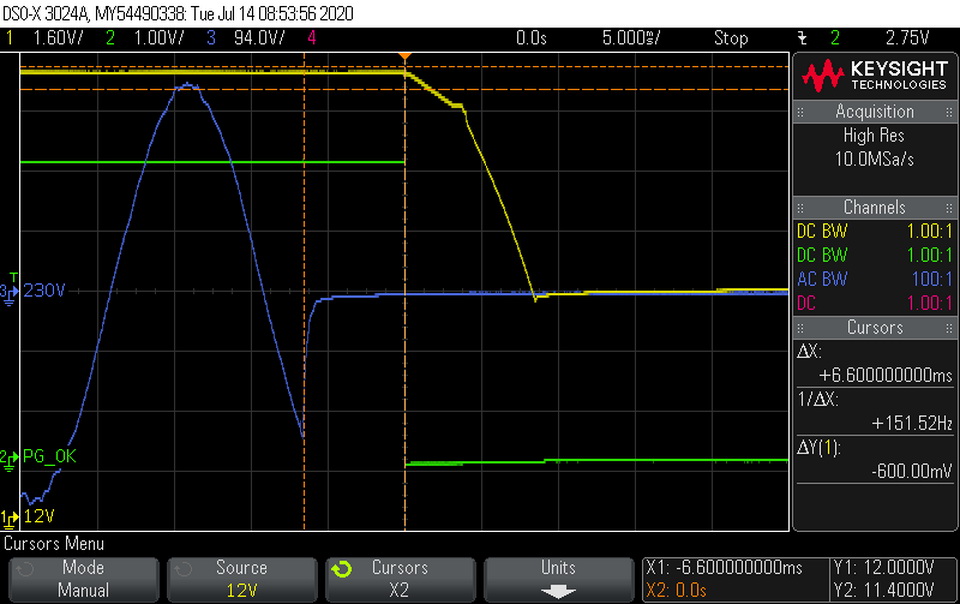
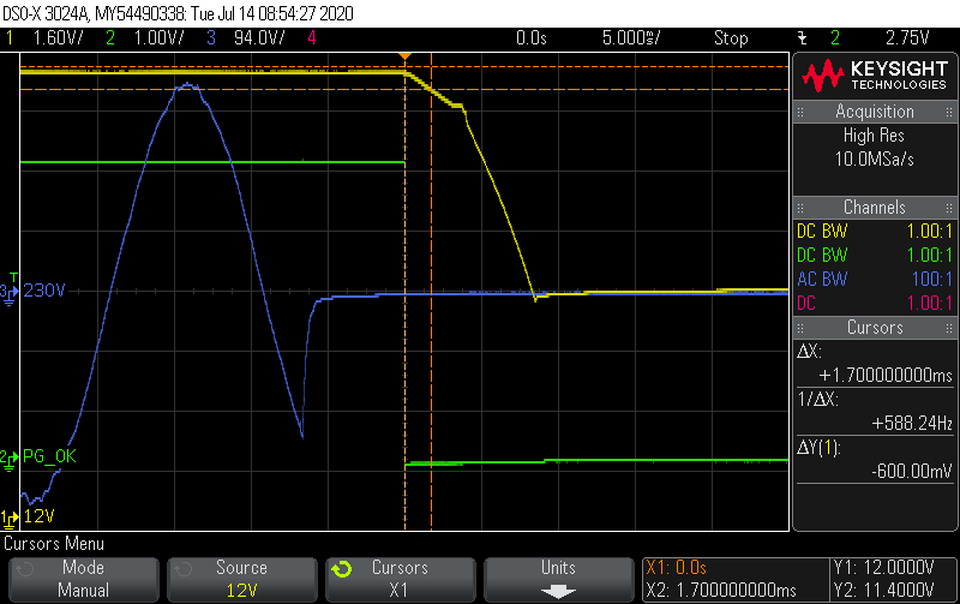
The hold-up time is much lower than 17ms, which is what the ATX spec recommends. This is a budget-oriented platform, so the bulk caps are small, to save money. Still, we would like to see a longer than 10ms hold-up time.
Inrush Current
Inrush current, or switch-on surge, refers to the maximum, instantaneous input current drawn by an electrical device when it is first turned on. A large enough inrush current can cause circuit breakers and fuses to trip. It can also damage switches, relays, and bridge rectifiers. As a result, the lower the inrush current of a PSU right as it is turned on, the better.
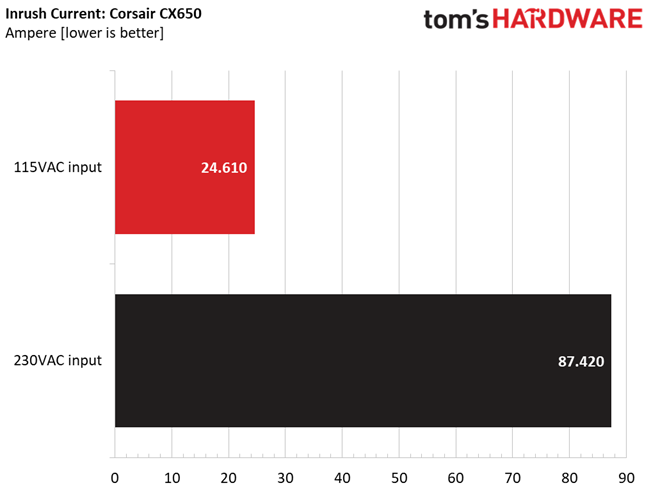
Results 13-14: Inrush Current

Typically, the inrush current is much higher with 230V input. Great Wall should use an NTC thermistor with higher resistance to lower it.
Get Tom's Hardware's best news and in-depth reviews, straight to your inbox.
10-110% Load Tests
These tests reveal the CX650's load regulation and efficiency levels under high ambient temperatures. They also show how the fan speed profile behaves under increased operating temperatures.
| Test # | 12V | 5V | 3.3V | 5VSB | DC/AC (Watts) | Efficiency | Fan Speed (RPM) | PSU Noise (dB[A]) | Temps (In/Out) | PF/AC Volts |
| 1 | 3.608A | 1.992A | 1.992A | 0.996A | 64.975 | 84.250% | 1024 | 22.4 | 33.86°C | 0.972 |
| 12.023V | 5.018V | 3.313V | 5.021V | 77.122 | 37.24°C | 115.14V | ||||
| 2 | 8.253A | 2.992A | 2.991A | 1.198A | 130.052 | 88.250% | 1106 | 25.1 | 34.90°C | 0.987 |
| 12.014V | 5.014V | 3.309V | 5.010V | 147.367 | 38.85°C | 115.13V | ||||
| 3 | 13.244A | 3.493A | 3.492A | 1.400A | 195.059 | 89.301% | 1208 | 27.8 | 35.33°C | 0.992 |
| 12.006V | 5.012V | 3.306V | 5.000V | 218.429 | 40.69°C | 115.13V | ||||
| 4 | 18.245A | 3.993A | 3.996A | 1.604A | 260.071 | 89.400% | 1258 | 29.0 | 35.71°C | 0.992 |
| 11.996V | 5.009V | 3.303V | 4.990V | 290.908 | 42.25°C | 115.12V | ||||
| 5 | 22.908A | 4.996A | 5.002A | 1.808A | 325.112 | 88.988% | 1357 | 31.2 | 36.07°C | 0.993 |
| 11.987V | 5.005V | 3.300V | 4.979V | 365.345 | 43.08°C | 115.12V | ||||
| 6 | 27.533A | 6.000A | 6.007A | 2.000A | 389.564 | 88.420% | 1471 | 34.1 | 36.63°C | 0.993 |
| 11.979V | 5.002V | 3.296V | 4.968V | 440.582 | 44.79°C | 115.12V | ||||
| 7 | 32.230A | 7.003A | 7.017A | 2.220A | 454.935 | 87.620% | 1609 | 36.4 | 37.20°C | 0.993 |
| 11.971V | 4.998V | 3.293V | 4.956V | 519.215 | 46.58°C | 115.11V | ||||
| 8 | 36.936A | 8.002A | 8.027A | 2.428A | 520.199 | 86.749% | 1755 | 39.2 | 37.93°C | 0.994 |
| 11.962V | 4.994V | 3.289V | 4.945V | 599.657 | 48.27°C | 115.11V | ||||
| 9 | 42.048A | 8.517A | 8.521A | 2.431A | 585.157 | 85.829% | 1808 | 39.5 | 38.77°C | 0.994 |
| 11.954V | 4.991V | 3.286V | 4.939V | 681.772 | 50.21°C | 115.10V | ||||
| 10 | 46.900A | 9.025A | 9.046A | 3.052A | 649.986 | 84.665% | 1810 | 39.6 | 39.20°C | 0.995 |
| 11.946V | 4.988V | 3.283V | 4.916V | 767.715 | 51.25°C | 115.10V | ||||
| 11 | 52.355A | 9.030A | 9.055A | 3.056A | 714.804 | 83.560% | 1813 | 39.7 | 40.71°C | 0.995 |
| 11.939V | 4.986V | 3.281V | 4.910V | 855.438 | 53.58°C | 115.09V | ||||
| CL1 | 0.102A | 16.005A | 16.000A | 0.000A | 133.938 | 81.807% | 1532 | 35.3 | 36.65°C | 0.989 |
| 12.009V | 4.996V | 3.297V | 5.025V | 163.725 | 43.57°C | 115.13V | ||||
| CL2 | 54.017A | 1.000A | 0.999A | 1.000A | 658.981 | 85.327% | 1812 | 39.6 | 39.93°C | 0.995 |
| 11.952V | 5.001V | 3.294V | 4.978V | 772.300 | 51.77°C | 115.10V |
The PSU can deliver its full load for a prolonged period at high operating temperatures, close to 41 degrees Celsius. The fan has to work over-hours, though, at such harsh conditions, to cope with the increased thermal load (117W at full load and 141W at the overload test).
20-80W Load Tests
In the following tests, we measure the CX650's efficiency at loads significantly lower than 10% of its maximum capacity (the lowest load the 80 PLUS standard measures). This is important for representing when a PC is idle with power-saving features turned on.
| Test # | 12V | 5V | 3.3V | 5VSB | DC/AC (Watts) | Efficiency | Fan Speed (RPM) | PSU Noise (dB[A]) | PF/AC Volts |
| 1 | 1.236A | 0.498A | 0.498A | 0.198A | 20.003 | 70.965% | 862 | 16.3 | 0.860 |
| 12.016V | 5.022V | 3.316V | 5.046V | 28.187 | 115.14V | ||||
| 2 | 2.470A | 0.994A | 0.996A | 0.397A | 39.995 | 80.578% | 910 | 18.2 | 0.943 |
| 12.025V | 5.021V | 3.315V | 5.039V | 49.635 | 115.14V | ||||
| 3 | 3.708A | 1.493A | 1.494A | 0.596A | 60.027 | 84.311% | 991 | 21.6 | 0.967 |
| 12.024V | 5.019V | 3.313V | 5.032V | 71.197 | 115.15V | ||||
| 4 | 4.939A | 1.994A | 1.993A | 0.796A | 79.977 | 85.799% | 1028 | 22.5 | 0.977 |
| 12.021V | 5.018V | 3.312V | 5.025V | 93.214 | 115.14V |
There is no need for high fan speeds at light loads, although the ambient during our tests was over 32 degrees Celsius. The efficiency levels are entirely satisfactory, as well.
2% or 10W Load Test
Intel plans on raising the ante at efficiency levels under ultra-light loads. So from July 2020, the ATX spec requires 70% and higher efficiency with 115V input. The applied load is only 10W for PSUs with 500W and lower capacities, while for stronger units we dial 2% of their max-rated-capacity.
| 12V | 5V | 3.3V | 5VSB | DC/AC (Watts) | Efficiency | Fan Speed (RPM) | PSU Noise (dB[A]) | PF/AC Volts |
| 0.889A | 0.257A | 0.257A | 0.049A | 13.074 | 63.102% | 829 | 14.8 | 0.788 |
| 12.016V | 5.023V | 3.316V | 5.051V | 20.719 | 115.13V |
It is nice to see over 60% efficiency in a low-cost platform.
Efficiency
Next, we plotted a chart showing the CX650’s efficiency at low loads, and loads from 10 to 110% of its maximum-rated capacity. The higher a PSU’s efficiency, the less energy goes wasted, leading to a reduced carbon footprint and lower electricity bills.

Results 15-18: Efficiency
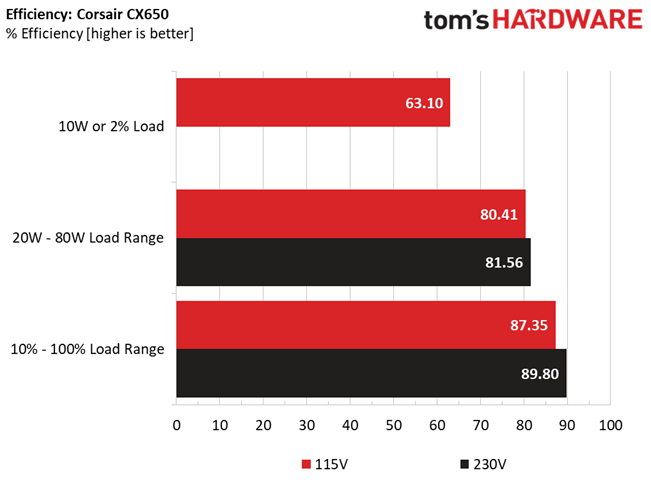


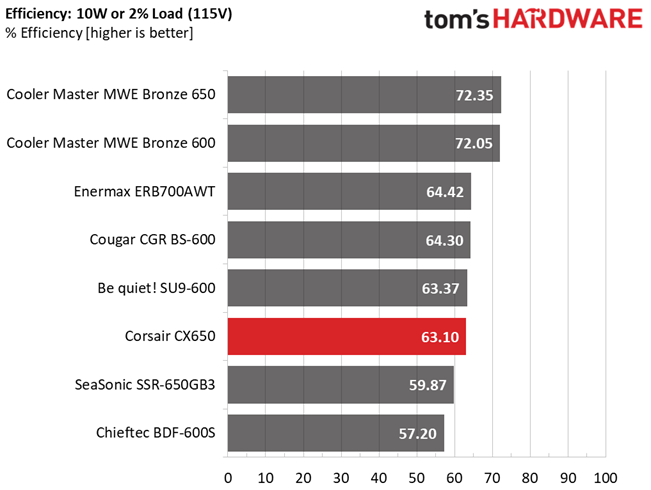
For the standards of this category, the CX650 uses a highly efficient platform. Nonetheless, Cooler Master's MWE Bronze units achieve amazing results in the 2% load test, since their designs are tuned for high efficiency under super-light loads.
5VSB Efficiency
| Test # | 5VSB | DC/AC (Watts) | Efficiency | PF/AC Volts |
| 1 | 0.100A | 0.505 | 75.940% | 0.076 |
| 5.050V | 0.665 | 115.11V | ||
| 2 | 0.250A | 1.262 | 79.873% | 0.163 |
| 5.046V | 1.580 | 115.11V | ||
| 3 | 0.550A | 2.772 | 81.076% | 0.271 |
| 5.039V | 3.419 | 115.11V | ||
| 4 | 1.000A | 5.028 | 80.901% | 0.346 |
| 5.027V | 6.215 | 115.11V | ||
| 5 | 1.500A | 7.523 | 81.128% | 0.386 |
| 5.015V | 9.273 | 115.11V | ||
| 6 | 3.000A | 14.931 | 78.353% | 0.444 |
| 4.977V | 19.056 | 115.12V |
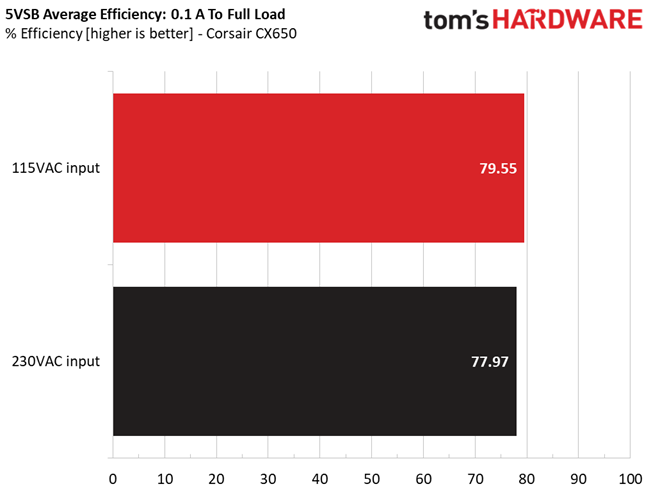
Results 19-20: 5VSB Efficiency
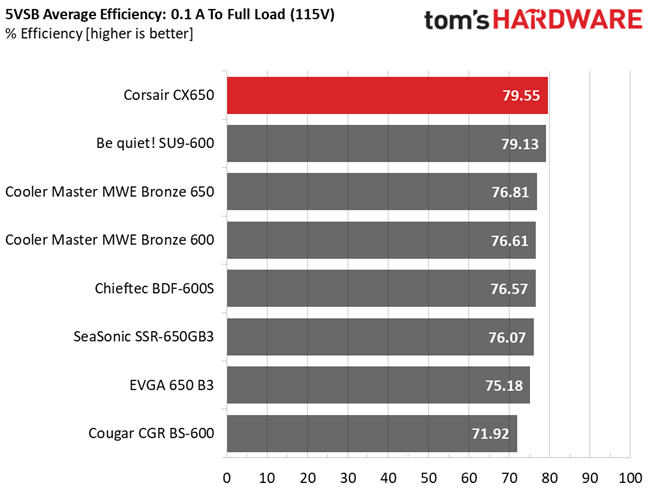
The 5VSB rail's efficiency is among the highest we have ever measured in this category.
Power Consumption In Idle And Standby
| Mode | 12V | 5V | 3.3V | 5VSB | Watts | PF/AC Volts |
| Idle | 12.051V | 5.023V | 3.315V | 5.053V | 11.460 | 0.597 |
| 115.1V | ||||||
| Standby | 0.058 | 0.007 | ||||
| 115.1V |

Results 21-22: Vampire Power
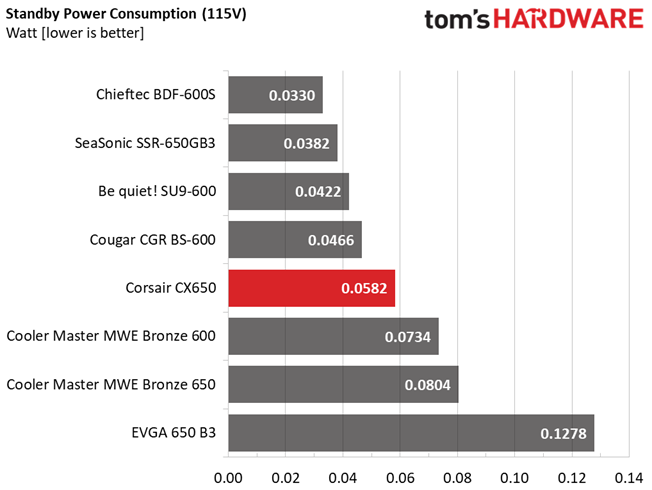
The energy levels that the PSU needs in standby are low and this helps the 5VSB rail's efficiency, at super-light loads.
Fan RPM, Delta Temperature, And Output Noise
All results are obtained between an ambient temperature of 32 to 41 degrees Celsius (89.6 to 105.8 degrees Fahrenheit).
The fan speed profile at high operating temperatures has a linear increase until 455W load. At higher loads, the fan has to spin at its full speed to cope with the load.
The following results were obtained at 30 to 32 degrees Celsius (86 to 89.6 degrees Fahrenheit) ambient temperature.
At lower ambient temperatures, there is no difference, as you can see in the charts above, in the fan speed profile. Great Wall could apply a more relaxed profile at lower temperatures, but its engineers preferred to stay on the safe side. There is room for improvement here unless they are too worried about the five-year warranty that Corsair offers to this product.
MORE: Best Power Supplies
MORE: How We Test Power Supplies
MORE: All Power Supply Content
Current page: Load Regulation, Hold-Up Time, Inrush Current, Efficiency and Noise
Prev Page Specifications and Part Analysis Next Page Protection Features, DC Power Sequencing, Cross-Load Tests and Infrared Images
Aris Mpitziopoulos is a contributing editor at Tom's Hardware, covering PSUs.
-
mdd1963 Lots of folks 'poo-poo' some of Corsair's PSU offerings, instead flocking to something w/Gold or Platinum in it'/s title, no matter the 150% price increase, and/or the 430W 'only' capacity...Reply
I've been happily using a Corsair 600 watt PSU (CX600) which cost me all of $55 or so in Feb 2017 if I recall correctly... ; never a stutter.

